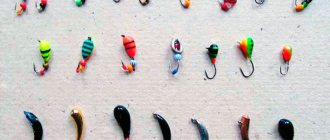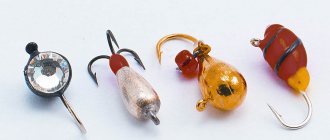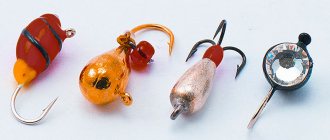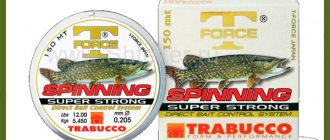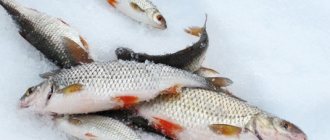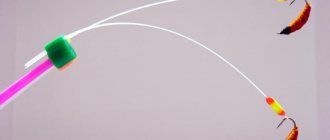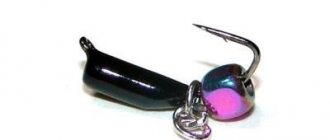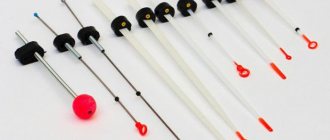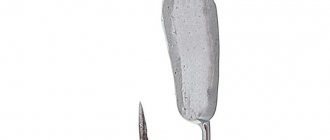In ice-bound waters, winter jig fishing is the most common fishing method. The vast majority of anglers practice jig fishing in winter, considering this the main method of fishing. Beginners are introduced to ice fishing with the simplest gear - fishing rods with a float or nod, equipped with these baits at the end of the fishing line for stand-up fishing.
However, stationary winter fishing is not the only working way to use jigs. No less common is active game fishing, which requires experience and effort from the winter driver, but often brings more catch. To hunt predators, large decoys are used, which can hardly be called jigs. In winter, fishing in the current differs from fishing in calm water. In this article we will look at how to fish with jigs in various winter water conditions.
Fishing with a jig in winter
For beginners, jig fishing in winter is a great opportunity to show your hunting instincts on the ice. This method is multifaceted, like fishing itself in general. Fishing methods are intertwined. Fishing with a jig is used in various ways - from catching crucian carp or rotan to serious hunting for schools of large roach, bream or predatory fish. The jig is an integral part of many winter fishing methods. Accordingly, there are countless variations in the design of these baits and fishing rod rigs. However, the entire vast area of jig fishing is divided into several large, seriously different areas of winter fishing.
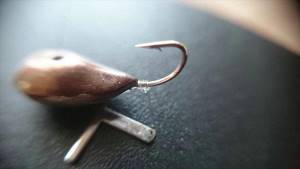
How to fish with a reelless jig and a jig?
When using a jig, there are several fishing methods:
With nozzle.
Just from the name alone it is clear that this method requires a bait that will be natural.
In this method, you can use jigs such as:
- Pellet;
- Droplet.
Without nozzle.
This same option requires the absence of bait and great skill of the fisherman, since it is difficult to catch fish without bait. This species is mainly used for catching rare and specific fish.
The most suitable baits may be:
- Devil;
- Nymph;
Types of winter jig fishing
You need to start fishing with a jig in winter with an ordinary fishing rod, stationary, with a bloodworm (more on that later), with a nod or a float, just to appreciate the beauty of ice fishing in principle. And then the whole endless world of winter fishing will open before the angler.
Tactics, fishing technique, equipment of gear depends on the fishing method:
- Stationary fishing (as with a winter float rod) from the bottom using bait. Typically, anglers use 2-3 or more fishing rods at the same time in well-fed holes.
- Game fishing with baiting bloodworms (moths).
- Baitless fishing (winter reelless fishing).

In addition to these three main directions, jigs are also used in other fishing methods in winter. These include ice donks, various garland locomotives, special baits for predators, as well as summer fishing with winter gear from a boat or a casting rod from the shore.
In jig fishing it is important:
- The choice of baits and tackle depending on the conditions and preferences of the fish.
- Correct tactics (stationary feeding, active search), features of winter reservoirs.
- All the nuances associated with groundbaits, baits and attachments.
- The type of fish that winter fish hunt.
- Weather and winter time.
- Specific unpredictable little things that always arise during any fishing.
- Correct game, selection of baits, ability to present bait to fish in winter and arouse the interest of underwater inhabitants.
- Hooking, reeling, removing the hook from the fish's mouth.
- Personal winter equipment, attitude, readiness to experiment.
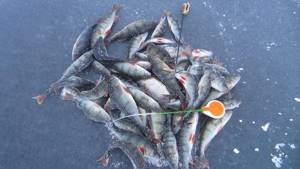
Reelless fishing
In the baitless version, jig fishing in winter has become a separate large area relatively recently. Technological progress has made it possible to use the thinnest fishing lines, light tackle and plastic hook decorations for fishing - everything that makes the reelless fish so catchy. This fishing method is fundamentally different from bait fishing. There is no bloodworm on the hook, and the angler arouses the fish's interest with the seductive action and configuration of the bait. Often, for beginners, the rewinder causes some difficulties - and all because of the initially incorrect approach. There are different principles at work here. Read more in the article about fishing in winter with a reelless bait.
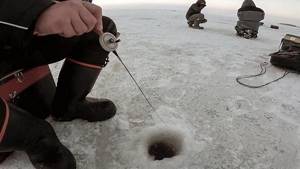
Nozzle jigs
Catching fish in winter with a jig without bloodworms largely depends on the configuration of the bait and the correct equipment, which allows you to give the desired game. In the baited version, the fisherman has the right to make a mistake - the bloodworm will still at the very least attract underwater inhabitants. The mothless one requires attentiveness to oneself. According to observations, fish caught without bait are on average larger. Underwater inhabitants perceive such bait as a complete object. In the attachment version, a piece of metal on the fore-end is needed to load the bait and deliver it to the bottom. The rewinder uses both ordinary models of trompe l’oeil with beads or other decorations, as well as specialized baitless devils, witches, goats, nymphs, ants, nail balls and others. Article about nozzle jigs:
Following the links provided on our website there is a whole series of articles describing all the intricacies of baitless winter fishing. Here we will dwell in more detail on bait fishing and look at how to fish in winter with a standard jig, with the addition of bloodworms or other bait.

What is a jig and its features
A jig is a bait that consists of a hook, and a piece of metal is soldered onto the shank of this hook, in most versions lead, tin or tungsten can also be used, sometimes made of simple black metal. Thanks to the original game of such a jig, any fish is attracted, it’s just that each type of fish uses its own jig, there are perch, pike, zander, for roach or bleak.
The fish gets the feeling that there is some kind of aquatic insect in front of it, which is why the fish attacks the jig. In order to give the jig an even greater resemblance to insects, beads and beads of bright colors are hung on it. The invention of such bait is purely Russian.
The jigs themselves can also be painted in a wide variety of colors so that they stand out in the water and are more noticeable to the fish. At the same time, jigs can also be made from precious metals - gold, silver, platinum, but such jigs are very rare and only very wealthy fishermen can afford them. Among other things, thanks to technological progress, anglers have many more tools, the use of which allows them to create the most incredible and effective models of winter jigs.
Fishing with jigs
The next block of information is those features that novice winter anglers often miss, and because of this they fail. But taking into account biting factors and correct tactics in winter is the key to success in ice fishing, regardless of the gear used. And jig fishing is no exception. Some beginners mistakenly think that the main thing in winter is the right equipment and the “best” magic bait that catches everything, always. Of course, equipment is important, but only technically, during fishing itself.
However, before you throw the tackle into the hole, you still need to find the right place. Underwater inhabitants live by their own rules, experiencing certain difficulties under the ice associated with a general slowdown in metabolism due to low temperature and sometimes lack of oxygen. How to catch fish with a jig correctly?
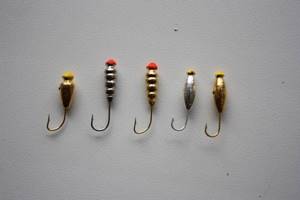
Before you cast your fishing rod, you need to think about the following:
- The nature of the reservoir and the type of fish. Before going on a winter fishing trip, it is important to understand where we are going and why. Each type of fish has specific behavioral and feeding characteristics. For the specific type of house, gear is also prepared in advance. Fishing with a jig on the current in winter will require some gear, fishing in still water will require others. On small rivers, fishing with jigs involves searching in promising places, using coastal landmarks. On large bodies of water, it is important to understand the bottom topography - in vast areas of water, in the vast expanses of the ice shell, promising places are not easy to find.
- Depends on the winter period. During the first ice, the bulk of the fish walk along vast coastal, relatively shallow places, and feed intensively. During this golden time you can catch it almost anywhere. In the dead of winter, it is located mainly at depth, therefore, a different search tactic is needed. By spring, underwater life accelerates again, the fish begin to feed more, preparing for the warm season.
- Internal factors of the reservoir. Weather, food migration, oxygen levels in the water - everything affects the winter bite. Each fish needs its own approach. This information is presented in articles on the website for specific types of fish.

Tactics
The specifics of the tactics directly depend on what kind of fish the subglacier intends to catch with a jig. Search, bait or spot feeding, constant movement or hatching, fishing location - it all depends on the fishing object and the characteristics of the reservoir. The tricks of winter fishing with jigs begin with the right choice of tactics, taking into account biting factors and the time of year.
Simple fishing for gudgeon in winter with a jig cannot be compared with the strategy of searching for schools of bream. Chasing a perch is different from spot feeding a roach. The winter jigs themselves for bream differ from those for perch, and for sorog the smallest, neatest baits are suitable. It all depends on the type of fish. Therefore, we tune in to a specific hunting object in advance, and do not go to catch “whatever comes along.”
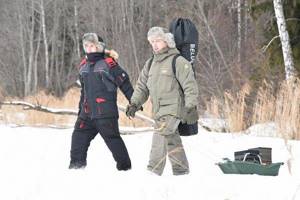
Active game fishing with one fishing rod implies active winter searching with a jig. The nature of the tactics depends on the time of winter. In December and on the first ice, coastal waters, grassy thickets, bays, and upper edges are examined. In the middle of nowhere, the strategic choice of location is more important, since the fish are located deeper at the winter mooring points. Any underwater anomalies are a promising place. Perch fishing with jigs is fast until a school is found.
For roach or bream, it is better to immediately carefully select a place and feed several points, then checking them in turn. Usually 10-15 holes are drilled at once, fed, and then checked. Feeding tactics are an integral part of the overall strategy. If there are no bites, the next square is drilled and examined. In addition to perch, roach and bream, jig catches include crucian carp, silver bream, bluefish, rudd, chub, ruffe, and dace. In the North and Siberia, grayling, trout, and whitefish are caught with these decoys. At sea - smelt.
Baits and lures
Bloodworms are often used as bait on a jig. Depending on the fishing conditions, one, two or a bunch of larvae are placed on the hook. In addition to bloodworms in winter, the following are used:
- Maggot;
- Worm;
- Caddisfly;
- Mormysh;
- Burdock moth larva (Chernobyl);
- Khrushchev (larvae);
- Semolina in a syringe;
- Canned corn (for chub).
Bait when fishing is a matter of experimentation. Depends on the type of fish and water conditions. However, the classic uses bloodworms, the natural food of underwater inhabitants.
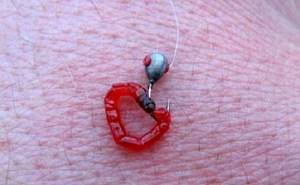
Working jigs
The main function of the attached jig is to unload the nod and deliver the bloodworm to the bottom. External beauty and color are secondary. Therefore, the basis of the moth set is made up of discreet baits. However, sometimes color affects the bite. Therefore, silver, red (copper) and yellow brass shades are useful when fishing. The best option for roach is miniature droplets and balls, for bream - elongated oats, uralkas, cloves. But for perch, a variety of options are useful - from nondescript black ones to bright, provocative parrots.
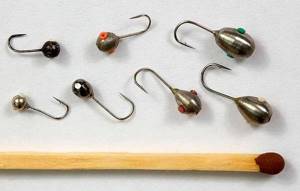
The main set is the usual forms of different weights and sizes
Jigs differ in shape and weight. Tungsten lures are better suited for deep-sea winter fishing. Even small tungsten jigs penetrate the water column well. Lead baits are lighter and cheaper. They are easy to process - fishermen often make homemade lead products with their own hands. When you need both large and light baits, it is better to use tin. For bait fishing, you don’t need to look for any extraordinary solutions. It is better to pay close attention to the classics - droplets, oats, pellets, uralkas. Attention is paid not to variety and colors, but to the quality of workmanship, the sharpness of the hook, and the absence of burrs in the hole. Read more in the article about attachment jigs.
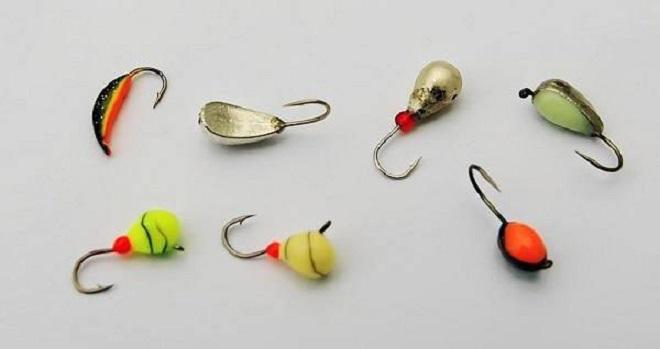
Perch
Fishing rods and equipment
Equipping fishing rods for winter jig fishing with game requires a more serious approach than for stationary fishing. The point of proper winter equipment is to ensure the sensitivity of the fishing rod, the ability to give the bait a seductive game. The correct tackle is a single “jig-line-nod” system, where the elements are selected depending on the weight of the bait. Therefore, advanced fishermen take several pre-configured gear to the pond at once (with baits of different weights, line thicknesses and elasticity of nods).
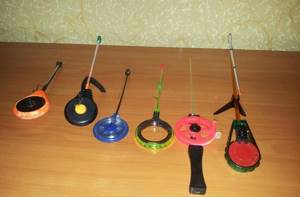
Tackle
In principle, almost any standard winter fishing rod is suitable for bait fishing. However, if an angler is seriously involved in jig fishing, it is better to use light axleless fishing rods, fillies or miniature sports balalaikas. A small and light rod makes it easier and easier to work all day.

Correspondence table for line weight and diameter
The determining role in the equipment is played by the correspondence of the weight of the bait, the diameter of the fishing line and the elasticity of the nod. The nod, moreover, is adjusted differently for fish species. Perch requires a high-frequency amplitude game and an elastic nod. For bream - smooth and slow vibrations, respectively, a long, soft nod is suitable. For roach, the lodge has some average characteristics between the first two. A properly tuned and selected nod provides the necessary amplitude and frequency of play, clearly shows touches of the bottom or attempts by fish to attack the bait, and registers cautious winter bites. Previously, nods for jigs were made from boar bristles. Currently, lavsan, X-ray film, carbon, and metal guards are used. Read more about nods to a jig fishing rod
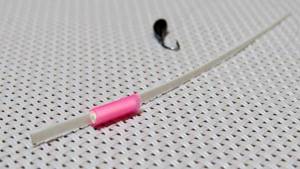
The choice of fishing line for winter jig fishing is determined by the weight of the bait and the size of the expected trophy. For those who like to use sports equipment with 0.06 mm fishing lines, it is not advisable - it is inconvenient to work with such a web. For small and medium-sized fish, the normal diameter is 0.08-0.1 mm, about 12 mm for larger ones. Even a kilogram bream in winter calmly reaches 0.1 mm, if you don’t force it. On a thick fishing line, the bait does not play properly. The water is clear in winter, so it is better to use invisible fluorocarbon. The general rule is that in winter it is better to use small baits and thin fishing lines.
The jig is tied to the fishing line depending on the configuration, location of the hole in the body or the ring. Tungsten lures require special attention - the hard metal easily injures the thin monofilament on the knot. We approach tying jigs carefully, after each fishing trip, especially intensive fishing, tying and updating the knots.
Article about rigging fishing rods for jigs:
https://podlednik.ru/snasti/mormyshki/zimnyaya-udochka-dlya-mormyshki

Fishing technique with a jig and bloodworm
Over time, each angler develops his own peculiarities of jig fishing techniques in winter. The game consists of combinations. Several repetitions of identical combinations make up a cycle. However, in bait fishing the rules of fishing are blurred, the game is often not rhythmic at all, but resembles sluggish twitching. Depending on the shape, weight, as well as the depth of fishing and the current, the massiveness of the bait, baits behave differently in the water.
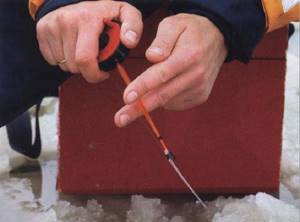
The nature of the game is also affected by the time of year. On the first ice and closer to spring, a fairly active, “fast” game is required. In the dead of winter, it is sluggish and slow (or the bait is generally motionless on the bottom). Perch prefers high-frequency rapid vibrations, bream prefers smooth and slow ones. Crucian carp responds well to swarming at the bottom and slow, low rises, but roach, on the contrary, likes the bait to lower, as if the food naturally sinks. In order to put all these variables together on a specific fishing trip, some experience and knowledge of the habits of underwater inhabitants is required. Therefore, theoretically, it is impossible to say exactly how to properly fish with a jig in winter. Basic wiring with which you should start, gradually adding grains of your own acquired experience:
- Sinking to the bottom, smoothly or with oscillatory movements. After a pause of 2-7 seconds, raise it by 4-5 cm.
- Stirring at the bottom, tapping, creating clouds of turbidity.
- Slow rise from the bottom to a height of 50 cm.
- Very slow rise with jerks every 3-5 seconds.
- Dribbling – high-frequency vibrations. Raising and lowering with frequency play.
- Dotted rise (lower). The movements of an amphipod are reminiscent of the fisherman's movements, as if the fisherman were drawing identical lines with his hand.
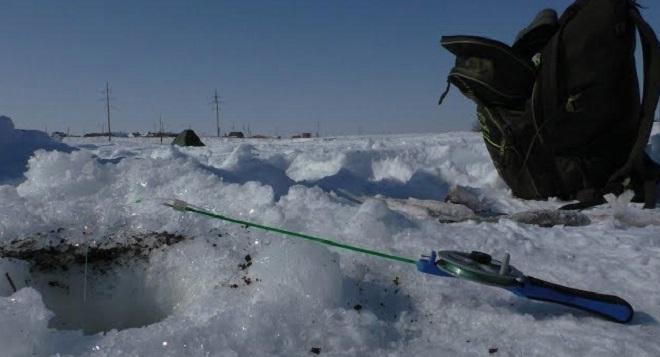
The most important element of the game is pauses. The closer to the wilderness, the longer the stops are required (up to 30 seconds). It is during pauses that bites often occur (especially from perch). If standard bite cycles do not bring any results, then the game should be diversified by changing the tempo, frequency, and speed. Provocative moments work well - accelerations, decelerations, oblique horizontal movements, changes in monotonous vibrations and unexpected pauses that were not previously in combination.
To catch fish with a jig, you need to constantly experiment with the game, select the frequency and speed of oscillations, and look for a working horizon. To fish with a jig on the current in winter, the game requires a slightly different one. In a stream, it is useful to release the bait with the flow with each step along the bottom further under the ice - the so-called undercut. In this case, a much larger area is fished. There are countless methods of fishing with a jig - each angler, based on basic elements, over time forms his own unique game.
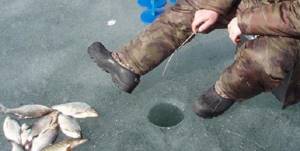
Some practical tips
Despite dozens of techniques for playing jigs, experience with this bait comes only through practice. Each time you need to select the amplitude of oscillations, as well as the speed of vertical and horizontal movement for a specific body of water, as well as a certain type of fish.
Fishermen with extensive experience in winter fishing give the following general recommendations:
- On the first ice, the jig must be moved very quickly and often vertically. This is explained by the increased activity of fish during the first ice.
- In the middle of winter, the fish becomes lethargic, so the amplitude of oscillations should be reduced, and the bait should be moved vertically very slowly.
- Closer to spring, the rise and fall of the jig should be very fast, the number of vibrations should be minimal, and the amplitude should be maximum.
Let the ice be strong and the catch rich!
(
20 ratings, average: 3.80 out of 5)

Margarita Pavlova
I am writing in the sections “Household Appliances” and “For Children”.
Internet journalist, copywriter with 8 years of experience and simply a creative person. I create interesting texts, immersing myself in every topic. I have a higher pedagogical education, I like order in everything, and I am interested in new fashionable devices.
Stationary fishing in winter
Fishing with a jig is also widely used in standard stationary fishing - with fishing rods with a float or a nod to the riser. In this case, the jig replaces the sinker with a hook. The equipment is carried out according to all the rules of winter float fishing. Attention is paid to the correct loading of the float (nod). Beginners find that it is enough to simply load a float or nod so that they clearly register bites on the rise. However, not everything is so smooth.
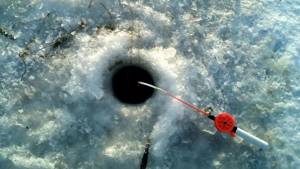
Often fish in the middle of nowhere will spit out the bait when they feel the weight of the jig in their mouth. Fine tuning of the gear is required, in which the float when rising or the nod when extending takes part of the load of the bait’s weight onto itself so that the fish does not feel it. This is especially true when catching bream from the bottom or low-active winter crucian carp. Bream equipment, moreover, is made taking into account the current (when fishing on rivers). More information about this can be found in the relevant articles on specific types of fish on a fishing rod and in publications on winter float fishing.
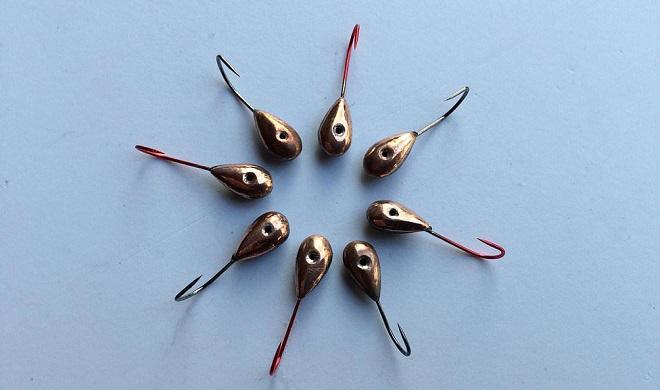
Classics of the genre
Fishing for predatory fish
Large heavy jigs, up to several centimeters in size and weighing tens of grams, are used for winter fishing for predatory fish. This kind of fishing is already closer to trolling - coarser gear is used that can withstand the weight of large fish and allows for proper play with heavy baits. Fry, sprat, and pieces of fish are placed on the hook. This fishing method is effective for pike perch and burbot.
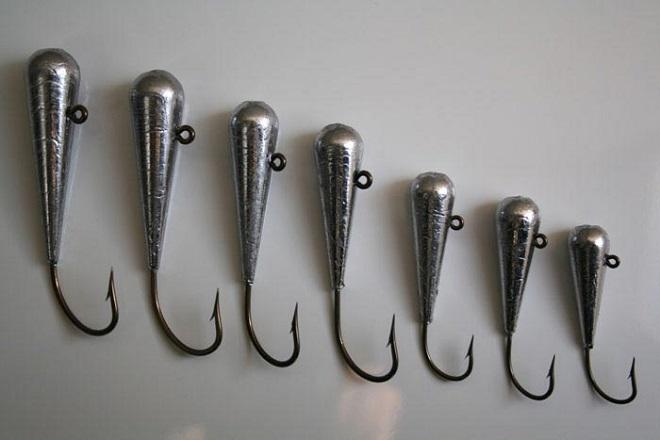
Winter jigs for burbot are the so-called snitches. These baits are made in such a way that when attaching a large bait, the jig can hit the rocks on the bottom with its back, raising the turbidity and creating sounds that are attractive to burbot. Winter pike-perch jigs, pellets and cones, are used both with active game and on risers with sprat or fry. The technique of going under the ice works well for pike perch in the current.
A popular way to catch rotan is using large baits with a piece of fish, lard or chicken skin attached. For this voracious predator, what is more important is not the jig itself, but the bait. Small jig heads are often used as jigs for winter rotan.
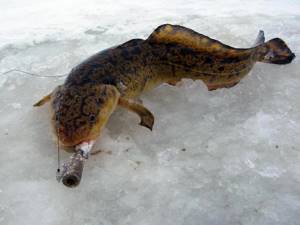
Types of jigs for winter fishing
As mentioned above, jigs vary in shape, color, weight and material.
Types of jigs:
- Ball ones don't play at all. When the rod moves, the hook moves. The species attracts fish with its thumping sound on the bottom;
- Cone-shaped - the fish grabs the jig completely, which allows it not to break off;
- Drop-shaped - effective for modelless fishing;
- Faceted - sparkling with their uneven side, they have a bewitching effect on the fish;
- Flat – Slow play and smooth movements can significantly increase your catch.
The most popular jigs are:
- Ball;
- Carnation;
- Uralka;
- Devil;
- Nymph.
Gvozdik
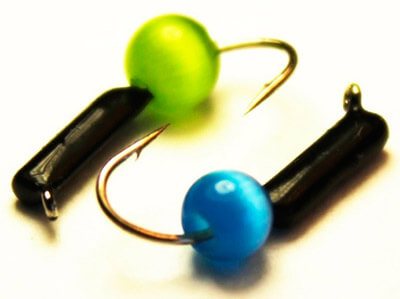
The appearance resembles a carnation, which is why this bait got its name, only instead of a cap there is a circle. High catchability and presence of sound during fishing. The most effective and popular bait from the nail-shaped category.
Classic Uralka

The Uralochka is the most common jig; it plays slowly and at great depths.
Features are:
- The shape is elongated and curved;
- Transmits vibration;
- Used at depth.
Nymph
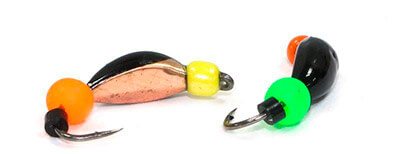
A nymph is a parody of an insect, whose creation consists of threads and fur. The equipment includes a wing, a stopper and a cambric. Among all existing mothless devices, it leads in its simplicity and lack of failures.
Devil
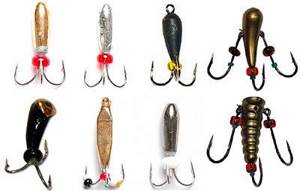
Devil is a catchable bait that is used for several fish. It got its name from its appearance, which resembles the image of a devil, namely, it has the shape of a slightly flattened ball with several hooks; bright beads are used together for biting.
Ball
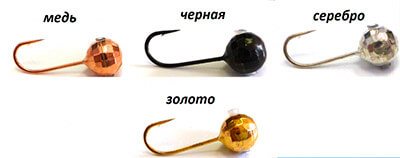
A hook with a ball at the very beginning. It can be made by independently choosing a dense material for the ball, which will be heavier than the hook itself.
Donkey
Fishing with jigs in the current is often used as part of winter donkeys. On helicopters and descents, various winter baits are used, but more often - light plastic or phosphor luminous jigs. Such gear is effective when fishing for bream, roach, bluegill and generally any white fish in the strong current of large rivers.
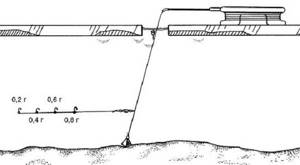
Steam locomotive on a leash
You can fish with jigs in winter using any means. It is important in each case to carefully and consciously approach the choice of bait, depending on the conditions of winter reservoirs and the preferences of the fish. You should not fall for marketing and advertising tricks by buying expensive and useless gear. It is better to master simple and working options, and only then, with the experience gained, experiment with new equipment.
Subscribe to the channel:
My YouTube channel RYBAFAN on fishing:
We're OK
How to attach a jig to a fishing line
Jigs can have an eye or a hole. To attach a jig with an eye or a ring, the tip of the fishing line should be inserted through the ring, then a loop is made along the hook, this loop, using a free fishing line, should be wound around the hook itself, making five to six turns.
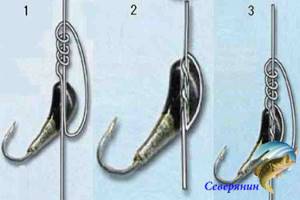
To secure a jig with a hole, the fishing line is threaded through the hole, tied in a knot, several turns are made around the shank of the hook, then the loop is moved closer to the tip of the hook and a sliding knot is made, the excess fishing line should be removed by cutting it off.
The most popular knots for attaching a jig to a fishing line during winter fishing are “Clinch”, “Palomar”, “Double Clinch”, “Eight”.
